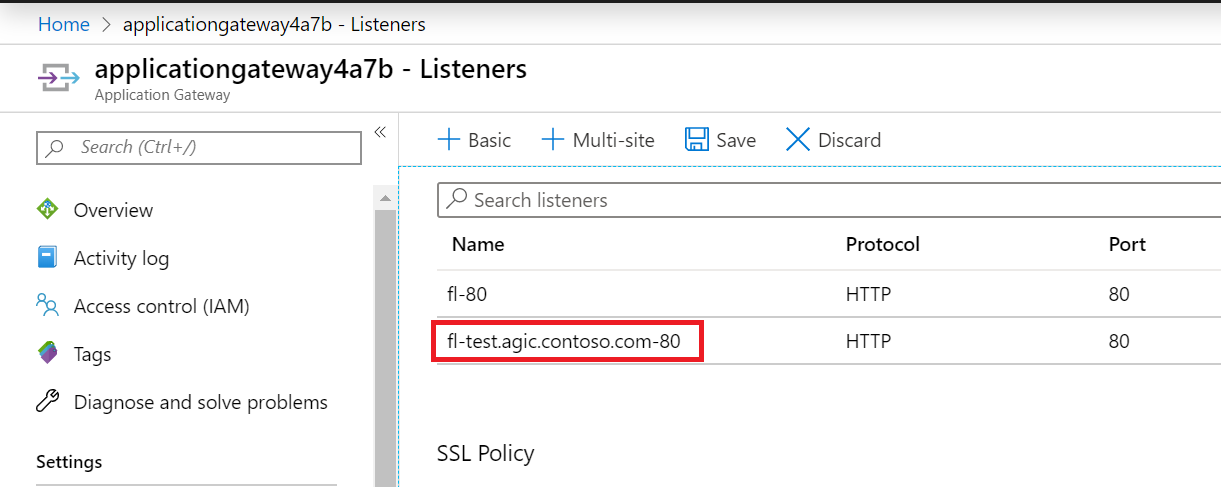使用简单的 Kubernetes 应用进行测试
以下步骤假定的情形为:
- 已有一个启用了高级网络的 AKS 群集
- 已在 AKS 群集上安装 AGIC
- VNET 上已有一个与 AKS 群集共享的应用程序网关
若要验证是否正确设置了应用程序网关 + AKS + AGIC 安装,请部署一个尽量简单的应用:
cat <<EOF | kubectl apply -f -
apiVersion: v1
kind: Pod
metadata:
name: test-agic-app-pod
labels:
app: test-agic-app
spec:
containers:
- image: "mcr.microsoft.com/dotnet/samples:aspnetapp"
name: aspnetapp-image
ports:
- containerPort: 80
protocol: TCP
---
apiVersion: v1
kind: Service
metadata:
name: test-agic-app-service
spec:
selector:
app: test-agic-app
ports:
- protocol: TCP
port: 80
targetPort: 80
---
apiVersion: networking.k8s.io/v1
kind: Ingress
metadata:
name: test-agic-app-ingress
annotations:
kubernetes.io/ingress.class: azure/application-gateway
spec:
#ingressClassName: azure-application-gateway # according to the AGIC setup guide, annotations are the approach to set the class
rules:
- host: test.agic.contoso.com
http:
paths:
- path: /
pathType: Prefix
backend:
name: test-agic-app-service
port:
number: 80
EOF
一次复制并粘贴之前脚本中的所有行。 核实复制整个命令 - 从 cat 开始,到最后的 EOF 为止。
成功部署应用后,AKS 群集中包含新的 Pod、服务和入口。
获取 Pod 列表:kubectl get pods -o wide。 预期已创建名为“test-agic-app-pod”的 Pod,且具有一个 IP 地址。 此地址必须在 AKS 所用的应用程序网关的 VNET 中。
获取服务列表:kubectl get services -o wide。 预期会看到名为“test-agic-app-service”的服务。
获取入口列表:kubectl get ingress。 预期已创建名为“test-agic-app-ingress”的入口资源。 该资源具有主机名“test.agic.contoso.com”。
其中一个 Pod 是 AGIC。
kubectl get pods 显示 Pod 列表,其中一个以“ingress-azure”开头。 使用 kubectl logs <name-of-ingress-controller-pod> 获取该 Pod 的所有日志,以验证部署是否成功。 如果部署成功,日志中会添加以下行:
I0927 22:34:51.281437 1 process.go:156] Applied Application Gateway config in 20.461335266s
I0927 22:34:51.281585 1 process.go:165] cache: Updated with latest applied config.
I0927 22:34:51.282342 1 process.go:171] END AppGateway deployment
或者,可以使用 kubectl logs <ingress-azure-....> | grep 'Applied App Gateway config in'(其中,<ingress-azure....> 应是 AGIC Pod 的确切名称)仅检索指示应用程序网关配置成功的行。
应用程序网关中应用了以下配置:
侦听器:

路由规则:

后端池:
- 后端地址池中有一个 IP 地址,该地址与前面使用
kubectl get pods -o wide 观测到的 Pod IP 地址相匹配
观测到的 Pod IP 地址相匹配
- 后端地址池中有一个 IP 地址,该地址与前面使用
最后,可以使用 cURL 命令来与新部署的应用建立 HTTP 连接:
- 使用
kubectl get ingress获取应用程序网关的公共 IP 地址 - 使用
curl -I -H 'test.agic.contoso.com' <public-ip-address-from-previous-command>
结果 HTTP/1.1 200 OK 表示应用程序网关 + AKS + AGIC 系统按预期方式工作。
检查 Kubernetes 安装
Pod、服务、入口
应用程序网关入口控制器 (AGIC) 持续监视以下 Kubernetes 资源:部署或 Pod、服务、入口
必须符合以下条件才能让 AGIC 按预期正常工作:
AKS 必须包含一个或多个正常的 Pod。 可使用
kubectl get pods -o wide --show-labels验证此配置。如果有一个包含apsnetapp的 Pod,则输出可能类似于:delyan@Azure:~$ kubectl get pods -o wide --show-labels NAME READY STATUS RESTARTS AGE IP NODE NOMINATED NODE READINESS GATES LABELS aspnetapp 1/1 Running 0 17h 10.0.0.6 aks-agentpool-35064155-1 <none> <none> app=aspnetapp一个或多个服务,通过匹配的
selector标签引用这些 Pod 。 使用kubectl get services -o wide验证此配置delyan@Azure:~$ kubectl get services -o wide --show-labels NAME TYPE CLUSTER-IP EXTERNAL-IP PORT(S) AGE SELECTOR LABELS aspnetapp ClusterIP 10.2.63.254 <none> 80/TCP 17h app=aspnetapp <none>入口,使用
kubernetes.io/ingress.class: azure/application-gateway批注,引用之前的服务。 使用kubectl get ingress -o wide --show-labels验证此配置delyan@Azure:~$ kubectl get ingress -o wide --show-labels NAME HOSTS ADDRESS PORTS AGE LABELS aspnetapp * 80 17h <none>查看之前入口的批注:
kubectl get ingress aspnetapp -o yaml(将aspnetapp替换为入口的名称)delyan@Azure:~$ kubectl get ingress aspnetapp -o yaml apiVersion: networking.k8s.io/v1 kind: Ingress metadata: annotations: kubernetes.io/ingress.class: azure/application-gateway name: aspnetapp spec: backend: serviceName: aspnetapp servicePort: 80必须使用
kubernetes.io/ingress.class: azure/application-gateway批注入口资源。
验证观测到的命名空间
获取 Kubernetes 群集中的现有命名空间。 应用在哪个命名空间中运行? AGIC 是否监视该命名空间? 有关如何正确配置观测到的命名空间,请参阅多命名空间支持文档。
# What namespaces exist on your cluster kubectl get namespaces # What pods are currently running kubectl get pods --all-namespaces -o wideAGIC Pod 应位于
default命名空间中(查看列NAMESPACE)。 正常的 Pod 在Running列中会显示为STATUS。 应至少有一个 AGIC Pod。# Get a list of the Application Gateway Ingress Controller pods kubectl get pods --all-namespaces --selector app=ingress-azure如果 AGIC Pod 不正常(之前命令中的
STATUS列不是Running),那么:- 获取日志来了解原因:
kubectl logs <pod-name> - 获取前面的 Pod 实例的日志:
kubectl logs <pod-name> --previous - 描述 Pod 以获取更多上下文:
kubectl describe pod <pod-name>
- 获取日志来了解原因:
-
# Get all services across all namespaces kubectl get service --all-namespaces -o wide # Get all ingress resources across all namespaces kubectl get ingress --all-namespaces -o wide 是否已使用 批注
kubernetes.io/ingress.class: azure/application-gateway? AGIC 只会监视具有此批注的 Kubernetes 入口资源。# Get the YAML definition of a particular ingress resource kubectl get ingress --namespace <which-namespace?> <which-ingress?> -o yamlAGIC 针对某些严重的错误发出 Kubernetes 事件。 可查看以下事件:
- 在终端中运行
kubectl get events --sort-by=.metadata.creationTimestamp - 在浏览器中使用 Kubernetes Web UI(仪表板)
- 在终端中运行
日志记录级别
AGIC 提供三个日志记录级别。 第 1 级别是默认级别,显示的日志行数极少。 而第 5 级别会显示所有日志,包括应用到 ARM 的配置的净化内容。
Kubernetes 社区已经为 kubectl 工具建立了九个日志记录级别。 在此存储库中,我们使用了其中三个语义类似的级别:
| 详细程度 | 说明 |
|---|---|
| 1 | 默认日志级别;显示启动详细信息、警告和错误 |
| 3 | 有关事件和更改的扩展信息;创建的对象列表 |
| 5 | 记录封送的对象;显示应用到 ARM 的已净化 JSON 配置 |
可通过 verbosityLevel 文件中的 变量调整详细级别。 将详细级别提高到 5 可以获取已分配到 ARM 的 JSON 配置:
示例 Helm 配置文件
# This file contains the essential configs for the ingress controller helm chart
# Verbosity level of the App Gateway Ingress Controller
verbosityLevel: 3
################################################################################
# Specify which application gateway the ingress controller manages
#
appgw:
subscriptionId: <subscriptionId>
resourceGroup: <resourceGroupName>
name: <applicationGatewayName>
# Setting appgw.shared to "true" creates an AzureIngressProhibitedTarget CRD.
# This prohibits AGIC from applying config for any host/path.
# Use "kubectl get AzureIngressProhibitedTargets" to view and change this.
shared: false
################################################################################
# Specify which kubernetes namespace the ingress controller watches
# Default value is "default"
# Leaving this variable out or setting it to blank or empty string would
# result in Ingress Controller observing all accessible namespaces.
#
# kubernetes:
# watchNamespace: <namespace>
################################################################################
# Specify the authentication with Azure Resource Manager
#
# Two authentication methods are available:
# - Option 1: AAD-Pod-Identity (https://github.com/Azure/aad-pod-identity)
armAuth:
type: aadPodIdentity
identityResourceID: <identityResourceId>
identityClientID: <identityClientId>
## Alternatively you can use Service Principal credentials
# armAuth:
# type: servicePrincipal
# secretJSON: <<Generate this value with: "az ad sp create-for-rbac --subscription <subscription-uuid> --role Contributor --sdk-auth | base64 -w0" >>
################################################################################
# Specify if the cluster is Kubernetes RBAC enabled or not
rbac:
enabled: false # true/false
# Specify aks cluster related information. THIS IS BEING DEPRECATED.
aksClusterConfiguration:
apiServerAddress: <aks-api-server-address>
查看应用程序网关活动日志
排查应用程序网关入口控制器问题时,除了 Kubernetes 资源之外,最好检查应用程序网关的活动日志。 每次 AGIC 应用新配置时,都会在 Azure 门户中的活动日志中记录相应的条目。 查看这些条目有助于确认配置更新是否已成功应用,并且通常会显示 Kubernetes 端不可见的网关相关问题。